Guild's BHM-01 Signature Guitar
Lots of pictures on this page, so read whilst you wait for the loading...
Now you can find out more about this awesome instrument. I got it in November 1996 and have been using on stage & in the studio ever since. I have taken some criticism on this -- after all, as one person told me, "The Brian May guitar is a collector's item that will surely be worth a lot of money some day." Well, I firmly believe that a guitar unused is a useless guitar. I do not buy expensive instruments as investments -- I use every guitar I own as a tool for my music. My BHM guitar is certainly no exception.
Recently I was clued in to some errata concerning my guitar by a netizen named Ron, who told me (and I quote): "[Y]our guitar is not a Professional Model; rather it is a Signature Model. There were 1,000 Signature models originally produced in '93, 500 for North America & 500 for Europe and other areas of the world. The Professional model began production in '94 with all the same specs as the Signature but without the "Brian May" signature decal on the back of the headstock.
This next bit of info should be very interesting to you. In '93 Guild (US Music) accidently shipped 50 random "European" Signature Models to Guitar Centers' distribution. These 50 guitars were then shipped throughout North America to various Guitar Centers. The European Signature Models are unique in that the serial numbers all start with ME, which stands for May Europe. So, not only do you own the top of the line Signature Model but you also have a rare European one here in the USA."
Thanks, Ron.
Guess what?? Now you can hear songs I've recorded on with my BHM guitar. My friend, Eric Davis (who, oddly enough, fronts the Eric Davis Band), uses my playing skills from time to time in his rather prolific recording.
He is currently working towards completing an album slated for release in 2000. You can download mp3 files of songs he's finished at Buy My Records Dot Com. There's actually no charge, he just asks that you put in your zip code so he can see where people are downloading from. He does not send out junk e-mail.
Anyway, the songs I played on are Seven of Nine (solo), Demented Little Love Song (harmony stuff & solo), and Away (From Here) (harmonized solo, stick bass, and rhythm in the chorus). In case you don't know, stick bass is a style of guitar playing usually found in ska/reggae music; when a guitarist doubles the bass line or mimics a bass line, it's called stick bass. Also, on the song Seven of Nine (a touching tribute to the hottest alien on television), I was purposely imitating Brian May's playing on Queen's Crazy Little Thing Called Love -- not the notes, but the tone and style, like those old-time Elvis guitar players. I came pretty close.
If Eric makes it big, watch for us on the road!
Pictures first -- then the parts. These pix were shot by me & scanned by my friend Tom.
The Pix
Click the thumbnail for the full-size pic

4 pictures |
 |
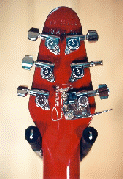 |
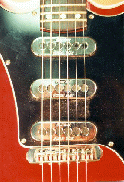 |
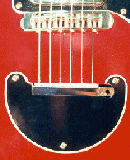 |
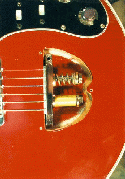 |
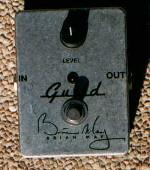
The Preamp Pedal
that came with my guitar. |
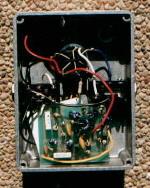 |
This space
intentionally
left blank. |
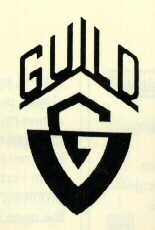
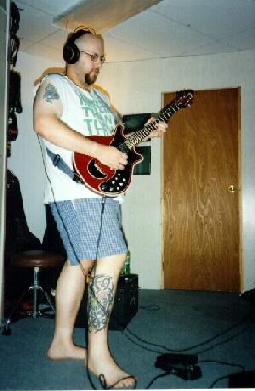
Playing one of many overdubs at Loch Ness
Daschund Studios in Falls Church, VA
Read about how I've modified my BHM
The Parts
body ... bridge ... head ... logo ... neck ... on/off switches ... phase switches ... pickguard ...
pickups ... specs ... tailpiece ... tone ... truss rod & cover ... tuning machines ... volume
Quotes taken from Owner's Manual
- The Body
- Constructed of high quality mahogany, "cut specially to show the beauty of the grain." Almost a semi-hollow construction, due to the smaller size of the body and the size of the hardware, control & electronics cavities. Finished to enhance the color or the wood. White binding all the way around, front and back. The body is (as far as I can tell) completely flat on both sides...no arches or contours at all. This makes the guitar sit a little far out when you stand up, unless you're as rail-thin as Brian. Also, the position of the lower bout curve and the weight of the wood make this a guitar you have to get used to sitting down with... List of Parts
- The Bridge
- Like the rest of the machined hardware on the BHM, the bridge is manufactured by Schaller (Germany). This bridge is a variation (and improvement) on a roller bridge they have been making for several years and it is quite good. On the BHM, the rollers help return the strings to exact pitch when you use the whang-bar, plus because they're not sharp, they help keep string breakage to a minimum. Since I got my BHM, I have yet to break a string... List of Parts
- The Head
- Tilted ever so slightly. No unsightly string trees. It's tapered, and kind of wide, which helps keep the strings going straight-through and helps prevent the strings from binding in the nut. A graphite nut helps keep the guitar in tune if you use the whang-bar, but if you use anything heavier than .009's, you may have to file the wound strings' slots out just a wee bit... List of Parts
- The Logo
- The Guild logo (just the Guild part, not the big G) is inlaid at the top of the head, in bright shining mother-of-pearl. The inlay is tight & cleanly done, no excess filler or sloppy work here! See the pix at the top... List of Parts
- The Neck & Fingerboard
- The first thing you notice when you pick up the Guild BHM is "MAN, the neck is wide. FAT, too!" The neck is 1-13/16 inch wide at the nut -- nearly as wide as a classical guitar, and definitely wider than most (if not all) other electric guitars. It's nearest competition width-wise may be the Gibson SG. The BHM's neck has several features that separate it from "regular" guitars. First of all, there is a zero fret, which makes bending low notes a breeze, plus helping keep the string tension down & keeping the strings at the correct height over the fingerboard. There are 24 low jumbo frets (between a Gibson Les Paul and a Fender Stratocaster), and because of the cut of the body, all 24 frets are easily accessible (trust me...I play a lot of high-voiced chords and octaves, no problem on this guitar). When I first got the guitar, it was obvious that Jeff, the previous owner, had not played it much as the frets were just a bit rough at their ends. Eight months of steady playing has remedied that problem. The fingerboard is beautiful solid ebony. The fret markers are a little different...two dots at the 7th (and 19th) & three at the 12th help you find your way a little easier. Like on the head, the inlay work is tight & clean with no extra filler material... List of Parts
- The Pickguard
- Nicely done, and very big! The pickups are screwed directly into the body, so the only things connected to the bottom of the pickguard are the pots & switches. The output jack is on the bottom. The controls are well laid-out and easy to reach, but the different configuration takes a little getting used to. The pickguard and tailpiece cover are both five-ply (b/w/b/w/b) plastic... List of Parts
- The Switches
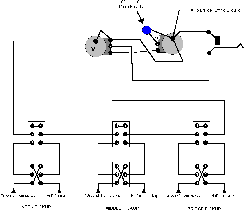 Along with the pickups, the switching system is what makes this guitar different from EVERY other guitar available. Each pickup has an on/off switch, so you can use any pickup alone, any pair, or all three. Additionally, they are wired in series (not parallel like a Stratocaster), so the inclusion of phase switches vastly expands the tonal palette available with this instrument. I use the Bridge & Middle pickups, In Phase, about 90% of the time. Other combinations I use are Neck & Middle, In Phase; Neck only; Middle only; Neck & Bridge, In Phase; and All Three, Bridge Out Of Phase (mostly for clean sounds)... List of Parts
Along with the pickups, the switching system is what makes this guitar different from EVERY other guitar available. Each pickup has an on/off switch, so you can use any pickup alone, any pair, or all three. Additionally, they are wired in series (not parallel like a Stratocaster), so the inclusion of phase switches vastly expands the tonal palette available with this instrument. I use the Bridge & Middle pickups, In Phase, about 90% of the time. Other combinations I use are Neck & Middle, In Phase; Neck only; Middle only; Neck & Bridge, In Phase; and All Three, Bridge Out Of Phase (mostly for clean sounds)... List of Parts
- The Pickups
- Custom made by Seymour Duncan for Guild's run of 1,000 BHM guitars (1993/4 edition that is). These pickups are a vast improvement over the DiMarzio's used on the 1984 BHM guitar. They "duplicate the original Burns Trisonic pickups" and have good output levels. The sound of each individual pickup is somewhere between a single coil & a humbucker (clear, but warm). When you use two pickups, the sound gets very meaty & rich. Also unlike the DiMarzio variations, you cannot purchase the Seymour Duncan Brian May pickups separately. The folks at SD have assured me, however, that if anything ever goes wrong with them, they will be MORE than happy to repair/rewind the BHM's pickups...I assume for a price!... List of Parts
- The Tailpiece
- Also manufactured by Schaller, mimics Brian's home-made tremolo system almost exactly. This tailpiece system is unlike any other vibrato system (like the standard Fender type, the Floyd Rose, or the Kahler -- which the 1984 BHM guitars had) in the world. It consists of a knife edge, a solid plate, two bolts, and two valve springs. You may have heard that Brian used motorcycle valve springs on the Original Red Special. Well...what's good enough for Brian is similarly used on the Guild copy. Has unusually smooth action and keeps the string tension low & helps prevent string breaks. The only downside is that to change the strings, you have to remove the plate covering the tailpiece's cavity. Small price to pay ... List of Parts
- The Volume & Tone Knobs & Pots
- One of each, standard 250K ohm pots and pretty silver bell knobs. The combination of these particular pots & the pickups allows you to finesse volume levels quite well, getting an almost clean sound from an excessively overdriven amplifier just by backing off the volume. I personally hate tone pots, and almost never use them, but I've found that backing the tone off to about 95% helps keep down feedback when I'm playing close to my amp. The volume is closer to the strings than the tone, but since it's so far back on the body, it takes a little getting used to as far as positioning goes... List of Parts
- The Truss Rod & Cover
- Standard truss rod construction (though I suspect it is a high quality rod). The plastic cover has "BHM" engraved in it... List of Parts
- The Tuning Machines
- Once again, exemplary products manufactured by Schaller. The action is smooth, the gear ratio is standard & these sealed units should last a lifetime. The only other company that makes good tuners is Gotoh, but you have to get the more expensive ones. Come to think of it, you have to do that with Schaller too... List of Parts
The Specs
Also copped from Another Queen Page
| Scale Length | 24" |
| Neck Width (at nut) | 1-13/16" |
| Neck Width (at 12th fret) | 2.025" |
| Neck Thickness (1st fret) | 0.85" |
| Neck Thickness (12th fret) | 0.92" |
| String Spacing (nut) | 1.576" |
| String Spacing (bridge) | 1.93" |
| 12th Fret Action (high E) |
1.5 mm |
| 12th Fret Action (low E) |
2.0 mm |
| Approximate Weight | 8 lbs |
| Body Thickness | 1.53" |
| Headstock Angle | 4° |
| Neck Pitch | 2° |
| Fingerboard Radius | 9" |
List of Parts
Modifications to My BHM Guitar
DO NOT MAKE MODIFICATIONS UNLESS YOU KNOW WHAT YOU'RE DOING. I cannot be held responsible for mistakes made -- and resulting damage -- on your BHM or any other instrument. Seek professional help if you have never worked on the guts of a guitar. I will be posting pictures of my mods as soon as I can.
- FIRST MOD:
- This one was quite simple. Since I use my BHM on stage, I need to make sure it doesn't fall off the strap. I replaced the stock strap buttons with Schaller Strap-Loks. This required removing the original buttons and screws and installing the new buttons and screws. The new screws are slightly longer (about 1/8") and the cosmetic difference is negligible. Tool required: Phillips-head screwdriver.
- SECOND MOD:
- I removed the connector for the whang bar. Since I never use these things, the post gets in my way. If you do this, make sure you go slowly -- there are ball-bearings and nylon washers that you will not want to lose. I used tape to make sure none of the pieces will get lost. The cosmetic difference is noticeable, but not terribly so. Tools required: broad flat-head screwdriver, tape.
- THIRD MOD:
- Since I took off the whang bar, and anticipating Mod #4, I knew I needed to find a way to block the bridge -- to keep it from moving at all. I slacked all the strings, then removed the bolt & spring assembly on the bass side. I replaced the spring with a 3cm piece of brass tubing (it actually is a trumpet part) and replaced the new bolt & tube assembly. The tube prevents the bridge from moving at all. Replacing both springs proved unecessary. Cosmetic difference is nil. Tools required: 10mm box-end wrench, hack saw (for the brass tube), small ruler or caliper.

Next page also contains a pic of all the bridge components
- FOURTH MOD:
- Hipshot. This device replaces the low E tuning machine. It enables me to change the tuning of the low E from E to D and back again just by flipping a small lever. The Hipshot is made by Schaller -- so I consider this an original-manufacturer replacement part. The head of the BHM is thicker than normal guitars, so I had to dig up a longer threaded sleeve and a thinner washer from my large box of spare parts. The Hipshot is secured with a small screw on the back of the guitar's head. The cosmetic difference is minor -- a small lever is visible just south of the low E machine head. Since it's a Schaller (as are the other tuners), the knobs all look the same. Tools required: small Phillips-head screwdriver, adjustable wrench.


Why did I make these mods? I have been asked that by several horrified BHM owners. Well -- my BHM is my main guitar, both on stage and in the studio. I am a working musician and I require certain things from my instruments. In my band's songs, I often switch from standard to Drop-D tuning, so in my case these weren't frivolous changes. I have all the original parts, so that if I want to return the guitar to "stock" I can.
I believe the person that would be the least critical of the mods I have made is Brian May. After all, he built the damn thing -- and had to do plenty of experimenting to get it right!
Thanks to Adolfo Dueñas Canales for the wiring diagram and pic of the bridge components.
 Back to the Brian May Page
Back to the Brian May Page
 Check out my on-stage and in-studio equipment
Check out my on-stage and in-studio equipment
Want more info? E ME :: NOTE :: I am NOT Brian May and I don't know how to contact him.

 23 July 2000
23 July 2000


















 Along with the pickups, the switching system is what makes this guitar different from EVERY other guitar available. Each pickup has an on/off switch, so you can use any pickup alone, any pair, or all three. Additionally, they are wired in series (not parallel like a Stratocaster), so the inclusion of phase switches vastly expands the tonal palette available with this instrument. I use the Bridge & Middle pickups, In Phase, about 90% of the time. Other combinations I use are Neck & Middle, In Phase; Neck only; Middle only; Neck & Bridge, In Phase; and All Three, Bridge Out Of Phase (mostly for clean sounds)... List of Parts
Along with the pickups, the switching system is what makes this guitar different from EVERY other guitar available. Each pickup has an on/off switch, so you can use any pickup alone, any pair, or all three. Additionally, they are wired in series (not parallel like a Stratocaster), so the inclusion of phase switches vastly expands the tonal palette available with this instrument. I use the Bridge & Middle pickups, In Phase, about 90% of the time. Other combinations I use are Neck & Middle, In Phase; Neck only; Middle only; Neck & Bridge, In Phase; and All Three, Bridge Out Of Phase (mostly for clean sounds)... List of Parts



 Back to the Brian May Page
Back to the Brian May Page
 Check out my on-stage and in-studio equipment
Check out my on-stage and in-studio equipment
 23 July 2000
23 July 2000